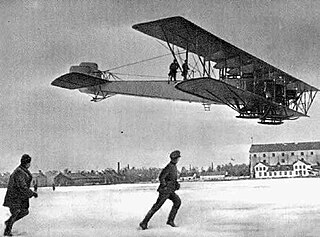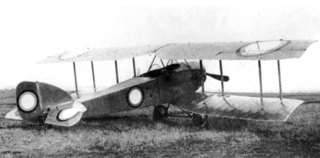
The Ilyushin Il-10 is a Soviet ground attack aircraft developed at the end of World War II by the Ilyushin construction bureau. It was also license-built in Czechoslovakia by Avia as the Avia B-33.

The Kharkiv KhAI-5, was a Soviet reconnaissance and light bomber aircraft, designed in the mid-1930s in the Kharkiv Aviation Institute, under the direction of Iosif Grigorevich Nyeman.

The Yakovlev Yak-11 is a trainer aircraft used by the Soviet Air Force and other Soviet-influenced air forces from 1947 until 1962.

The Yakovlev UT-2 is a single-engine tandem two-seat low-wing monoplane that was the standard Soviet trainer during World War II. It was used by the Soviet Air Force from 1937 until replaced by the Yakovlev Yak-18 during the 1950s.

The Yakovlev UT-1 was a single-seater trainer aircraft used by the Soviet Air Force from 1937 until the late 1940s.

The Yakovlev Yak-12 is a light multirole STOL aircraft used by the Soviet Air Force, Soviet civilian aviation and other countries from 1947 onwards.

The Hansa-Brandenburg B.I was an unarmed military trainer and reconnaissance biplane of World War I, flown by the Austro-Hungarian Air Service. Early models were known internally to the Hansa-Brandenburg firm as the type D, while later models with a more powerful engine were designated FD. This aircraft was one of the earliest designs of Ernst Heinkel, who was working for Hansa-Brandenburg at the time. It was an entirely conventional two-bay biplane with staggered wings of unequal span. The pilot and observer sat in tandem in a long open cockpit.

The Sikorsky Ilya Muromets was a class of Russian pre-World War I large four-engine commercial airliners and military heavy bombers used during World War I by the Russian Empire. The aircraft series was named after Ilya Muromets, a hero from Slavic mythology. The series was based on the Russky Vityaz or Le Grand, the world's first four-engined aircraft, designed by Igor Sikorsky. The Ilya Muromets aircraft as it appeared in 1913 was a revolutionary design, intended for commercial service with its spacious fuselage incorporating a passenger saloon and washroom on board. The Ilya Muromets was the world's first multi-engine aircraft in production and at least sixty were built. During World War I, it became the first four-engine bomber to equip a dedicated strategic bombing unit. This heavy bomber was unrivaled in the early stages of the war, as the Central Powers had no aircraft capable enough to rival it until much later.

The Polikarpov Po-2 was an all-weather multirole Soviet biplane, nicknamed Kukuruznik. The reliable, uncomplicated design of the Po-2 made it an ideal trainer aircraft, as well as doubling as a low-cost ground attack, aerial reconnaissance, psychological warfare and liaison aircraft during war, proving to be one of the most versatile light combat types to be built in the Soviet Union. As of 1978 it remained in production for a longer period of time than any other Soviet-era aircraft. It holds the distinction of the only biplane to take down a jet aircraft.

The Salmson 2 A.2, was a French biplane reconnaissance aircraft developed and produced by Salmson to a 1916 requirement. Along with the Breguet 14, it was the main reconnaissance aircraft of the French army in 1918 and was also used by American Expeditionary Force aviation units. At the end of the First World War, one-third of French reconnaissance aircraft were Salmson 2s.

The Bücker Bü 133 Jungmeister is an advanced trainer of the Luftwaffe in the 1930s. It was a single-engine, single-seat biplane of wood and tubular steel construction and covered in fabric.
The Anatra V.I. was a Russian reconnaissance aircraft of World War I. It was a redesign of the French Voisin III undertaken by Podporuchik Piotr Ivanov in Zhmerynka. The Voisin's fuselage pod was replaced by a streamlined, plywood construction that included an all-new mount for the observer's machine gun and an aluminium firewall between the pilot's cockpit and the aircraft's fuel tank. The wings and landing gear were strengthened as well. Despite the machine's greater weight, it was 20 km/h (12 mph) faster in the air than the Voisin that it was based on, and was quickly ordered into production. In practice, however, the aircraft that reached operational units were poorly built and therefore disliked by their crews.
Anatra (Анатра) was an aircraft manufacturer founded by Artur Antonovich Anatra at Odesa, Ukraine, then Russian Empire in 1913 which manufactured aircraft until 1917. Artur Anatra had previously helped fund the purchase of the first aircraft to arrive in the Russian Empire, in 1909.

The Anatra D or Anade was a two-seat reconnaissance aircraft built in Odessa, Russian Empire and flown during World War I. It was a two-bay biplane of conventional configuration that seated the pilot and observer in tandem, open cockpits. Test flights revealed a number of design flaws, including weak wing structure that would later kill the company test pilot on 21 July 1917 and poor stability. Despite the problems, the aircraft was ordered into production by the Army, and deliveries commenced in May 1916 after revisions had been made to correct the aircraft's centre of gravity in the hope of addressing the worst handling problems. The type continued in limited service after the war, eventually being used as a trainer until about 1919.

The Halberstadt C.V was a German single-engined reconnaissance biplane of World War I, built by Halberstädter Flugzeugwerke. Derived from the Halberstadt C.III, with a more powerful supercharged 160 kW (220 hp) Benz Bz.IVü engine, it saw service only in the final months of the war. Cameras were mounted in the observer's cockpit floor.

The Hansa-Brandenburg C.I, also known as Type LDD, was a 2-seater armed single-engine reconnaissance biplane designed by Ernst Heinkel, who worked at that time for the parent company in Germany. The C.I had similarities with the earlier B.I, including inward-sloping interplane bracing struts. Like other early-war Austro-Hungarian reconnaissance aircraft, such as C-types of Lloyd or Lohner, the Type LDD had a communal cockpit for its crew.

The Lebed XII was a Russian military reconnaissance aircraft produced during the First World War for the Imperial Russian Air Force. It was one of the few domestically designed aircraft to see production in Russia during the war, but was based on designs and techniques learned from Lebed's rebuilding of captured German types. The fuselage was a plywood structure of rectangular cross-section with seating for the pilot and observer in tandem, open cockpits. The wings were built around a pine spar and covered in fabric, and the empennage was of welded steel tube with fabric covering.

The Anatra Anadis was developed in 1916 as a single-seat fighter variant of the Anatra Anasal reconnaissance biplane. The main difference between the two aircraft was the streamlined fuselage, the lack of a rear seat in the Anadis, plans for a forward-firing gun and a different engine.

The Henry Farman HF.30 was a two-seat military biplane designed in France around 1915, which became a principal aircraft of the Imperial Russian Air Service during the First World War. Although it was widely used on the Eastern Front, and by the factions and governments that emerged in the subsequent Russian Civil War, it is not well known outside that context: the HF.30 was not adopted by other Allied air forces, and the manufacturers reused the "Farman F.30" designation for the Farman F.30 in 1917.
The Anatra DE was a three-engined prototype Russian medium bomber of World War I. The biplane bomber was designed to hold four people. It was planned to use three engines to reach its target, then return using only one engine, having been lightened after dropping its payload. There was a single 140 hp Salmson engine at the front of the fuselage, and an 80 hp Le Rhône engine on each wing, which turned propellers attached to the rear of the engine, behind the wing. These engines were placed in a pusher configuration, and each wing also had a gun turret one each engine nacelle. In total, the aircraft had three guns, and could carry 400 kg of bombs. The only prototype that was built, weighing 327 kg more than expected, first flew on June 23, 1916. During testing, however, the fuselage and rear propellers became damaged when a tail skid broke, and it became evident that the design needed to be changed; the project was then abandoned.

















